Administration of thimerosal to infant rats increases overflow of glutamate and aspartate in the prefrontal cortex: protective role of dehydroepiandrosterone sulfate
- PMID: 22015977
- PMCID: PMC3264864
- DOI: 10.1007/s11064-011-0630-z
Administration of thimerosal to infant rats increases overflow of glutamate and aspartate in the prefrontal cortex: protective role of dehydroepiandrosterone sulfate
Abstract
Thimerosal, a mercury-containing vaccine preservative, is a suspected factor in the etiology of neurodevelopmental disorders. We previously showed that its administration to infant rats causes behavioral, neurochemical and neuropathological abnormalities similar to those present in autism. Here we examined, using microdialysis, the effect of thimerosal on extracellular levels of neuroactive amino acids in the rat prefrontal cortex (PFC). Thimerosal administration (4 injections, i.m., 240 μg Hg/kg on postnatal days 7, 9, 11, 15) induced lasting changes in amino acid overflow: an increase of glutamate and aspartate accompanied by a decrease of glycine and alanine; measured 10-14 weeks after the injections. Four injections of thimerosal at a dose of 12.5 μg Hg/kg did not alter glutamate and aspartate concentrations at microdialysis time (but based on thimerosal pharmacokinetics, could have been effective soon after its injection). Application of thimerosal to the PFC in perfusion fluid evoked a rapid increase of glutamate overflow. Coadministration of the neurosteroid, dehydroepiandrosterone sulfate (DHEAS; 80 mg/kg; i.p.) prevented the thimerosal effect on glutamate and aspartate; the steroid alone had no influence on these amino acids. Coapplication of DHEAS with thimerosal in perfusion fluid also blocked the acute action of thimerosal on glutamate. In contrast, DHEAS alone reduced overflow of glycine and alanine, somewhat potentiating the thimerosal effect on these amino acids. Since excessive accumulation of extracellular glutamate is linked with excitotoxicity, our data imply that neonatal exposure to thimerosal-containing vaccines might induce excitotoxic brain injuries, leading to neurodevelopmental disorders. DHEAS may partially protect against mercurials-induced neurotoxicity.
Figures
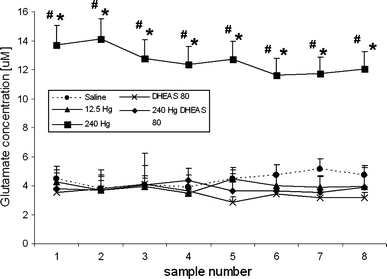
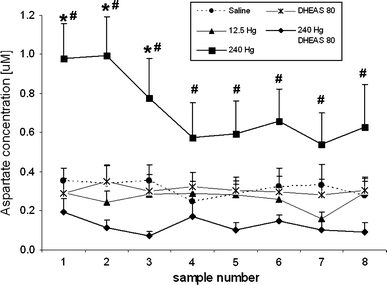
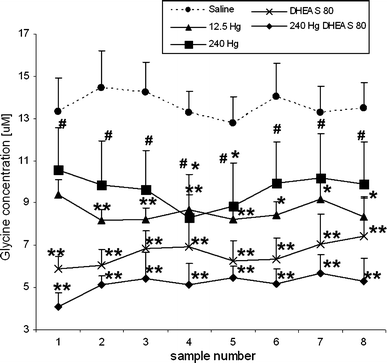
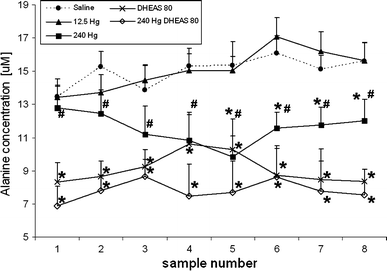
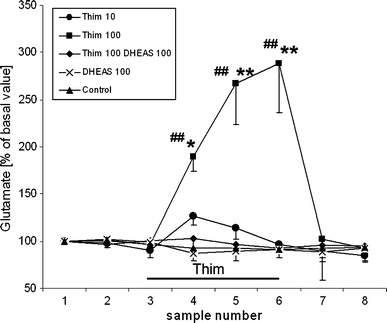
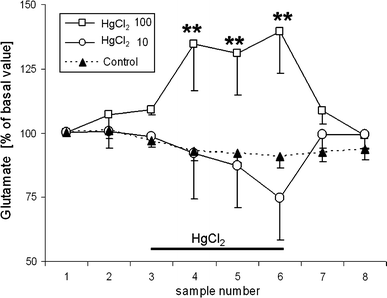
Similar articles
-
Cortical kynurenic acid bi-directionally modulates prefrontal glutamate levels as assessed by microdialysis and rapid electrochemistry.Neuroscience. 2010 Sep 15;169(4):1848-59. doi: 10.1016/j.neuroscience.2010.05.052. Epub 2010 Jun 19. Neuroscience. 2010. PMID: 20600676 Free PMC article.
-
Lasting neuropathological changes in rat brain after intermittent neonatal administration of thimerosal.Folia Neuropathol. 2010;48(4):258-69. Folia Neuropathol. 2010. PMID: 21225508
-
Neurotensin modulation of acetylcholine, GABA, and aspartate release from rat prefrontal cortex studied in vivo with microdialysis.Brain Res Bull. 2008 Sep 30;77(2-3):129-35. doi: 10.1016/j.brainresbull.2008.04.003. Epub 2008 May 7. Brain Res Bull. 2008. PMID: 18721670
-
Effect of acute and chronic administration of citalopram on glutamate and aspartate release in the rat prefrontal cortex.Pol J Pharmacol. 2000 Nov-Dec;52(6):441-8. Pol J Pharmacol. 2000. PMID: 11334237
-
Comparison of cocaine- and methamphetamine-evoked dopamine and glutamate overflow in somatodendritic and terminal field regions of the rat brain during acute, chronic, and early withdrawal conditions.Ann N Y Acad Sci. 2001 Jun;937:93-120. doi: 10.1111/j.1749-6632.2001.tb03560.x. Ann N Y Acad Sci. 2001. PMID: 11458542 Review.
Cited by
-
Neurodevelopment of Amazonian infants: antenatal and postnatal exposure to methyl- and ethylmercury.J Biomed Biotechnol. 2012;2012:132876. doi: 10.1155/2012/132876. Epub 2012 Apr 26. J Biomed Biotechnol. 2012. PMID: 22619491 Free PMC article.
-
The Novel Potential Therapeutic Utility of Montelukast in Alleviating Autistic Behavior Induced by Early Postnatal Administration of Thimerosal in Mice.Cell Mol Neurobiol. 2021 Jan;41(1):129-150. doi: 10.1007/s10571-020-00841-2. Epub 2020 Apr 17. Cell Mol Neurobiol. 2021. PMID: 32303879 Free PMC article.
-
Effects of Thimerosal on Lipid Bilayers and Human Erythrocytes: An In Vitro Study.J Membr Biol. 2016 Dec;249(6):823-831. doi: 10.1007/s00232-016-9933-y. Epub 2016 Oct 13. J Membr Biol. 2016. PMID: 27738716
-
Marked elevation of adrenal steroids, especially androgens, in saliva of prepubertal autistic children.Eur Child Adolesc Psychiatry. 2014 Jun;23(6):485-98. doi: 10.1007/s00787-013-0472-0. Epub 2013 Sep 17. Eur Child Adolesc Psychiatry. 2014. PMID: 24043498 Free PMC article.
-
Abnormal Brain Connectivity Spectrum Disorders Following Thimerosal Administration: A Prospective Longitudinal Case-Control Assessment of Medical Records in the Vaccine Safety Datalink.Dose Response. 2017 Mar 16;15(1):1559325817690849. doi: 10.1177/1559325817690849. eCollection 2017 Jan-Mar. Dose Response. 2017. PMID: 28539852 Free PMC article.
References
-
- Qvarnström J, Lambertsson L, Havarinasab S, Hultman P, Frech W. Determination of methylmercury, ethylmercury, and inorganic mercury in mouse tissues, following administration of thimerosal, by species-specific isotope dilution GC-inductively coupled plasma-MS. Anal Chem. 2003;75:4120–4124. doi: 10.1021/ac0342370. - DOI - PubMed
Publication types
MeSH terms
Substances
LinkOut - more resources
Full Text Sources
Miscellaneous

